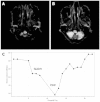Symptomatic hyponatremia following lateral medullary infarction: a case report
- PMID: 24886592
- PMCID: PMC4032626
- DOI: 10.1186/1471-2377-14-111
Symptomatic hyponatremia following lateral medullary infarction: a case report
Abstract
Background: Hyponatremia has been reported from patients with severe neurological disease, and the syndrome of inappropriate secretion of antidiuretic hormone and cerebral salt wasting syndrome are the two main etiologies of hyponatremia after brain injury. Here we describe a patient with a lateral medullary infarction who experienced symptomatic hyponatremia with finding suggestive of syndrome of inappropriate secretion of antidiuretic hormone followed by cerebral salt wasting syndrome.
Case presentation: A 70-year-old Korean man visited emergency room complaining of sudden onset vertigo and gait disturbance. Neurological exam showed left side ataxia, Horner syndrome, and right side hypesthesia. Brain magnetic resonance imaging disclosed acute infarction involving left lateral medulla. His neurological status was stabilized, but he began to complain of non-vertiginous dizziness and general weakness five days after admission. Serum sodium level dropped from 131 mEq/mL to 122 mEq/mL with reduced serum osmolarity of 265 mOsm/L. The diagnosis of syndrome of inappropriate secretion of antidiuretic hormone was made and we restricted fluid intake, but his symptoms worsened and his mental status became drowsy. Follow up serum sodium level was 108 mEq/L with volume loss, suggesting cerebral salt wasting syndrome. We treated him with hypertonic saline and his consciousness was recovered.
Conclusion: This case shows symptomatic hyponatremia after lateral medullary infarction, providing insight about distinct pathogenesis of syndrome of inappropriate secretion of antidiuretic hormone and cerebral salt wasting syndrome.
Figures

References
Publication types
MeSH terms
Substances
LinkOut - more resources
Full Text Sources
Other Literature Sources

